Nitin Singhania Summary: Indian Architecture, Sculpture & Pottery- 1 | History for UPSC CSE PDF Download
Introduction to Indian Architecture, Sculpture & Pottery
Indian Architecture, Sculpture & Pottery is a very important topic in respect to UPSC CSE. Let’s have a look at the summary of Nitin Singhania’s book to understand better.
Indian Architecture: Architecture refers to the design and construction of buildings. It generally uses a mixture of various types of materials like stone, wood, glass, metal, sand, etc. It involves the study of engineering and engineering mathematics. It requires detailed and accurate measurements.
Sculpture: Sculptures are relatively smaller 3-dimensional works of art. A single piece of the sculpture is usually made of a single type of material. Sculpture involves creativity and imagination and may not depend as heavily on accurate measurements.
Pottery: Pottery is the process and the products of forming vessels and other objects with clay and other ceramic materials, which are fired at high temperatures to give them a hard, durable form. Major types include earthenware, stoneware and porcelain.
Classification of Indian Architecture & Sculpture & Pottery
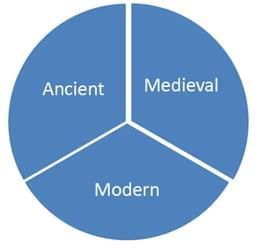
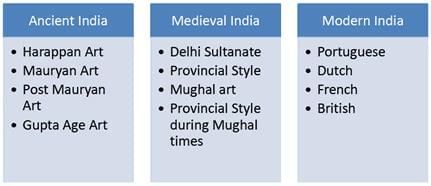
Ancient India and its Architecture
(a) Harappan Art
Harappan Architecture: The Indus Valley is one of the world's earliest urban civilizations, along with its contemporaries, Mesopotamia and Ancient Egypt. At its peak, the Indus Civilization may have had a population of well over five million.
What is Extensive Town Planning?
➢ The Great Granary at Harappa: Extensive town planning was the characteristic of this civilization, which is evident from the gridiron pattern for the layout of cities, some with fortifications and elaborate drainage and water management systems.
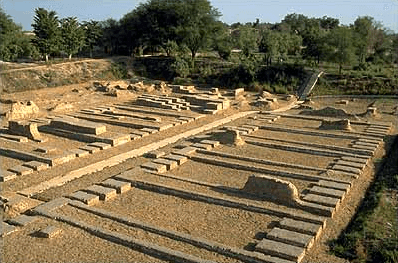 The Great Granary
The Great Granary
- The grid layout planning of the cities with roads at exact right angles is an ancient system that was implemented in the cities of this particular civilization.
- The houses were built of baked bricks. Bricks of fixed sizes, as well as stone and wood, were also used for building.
- Buildings in the lower area are rather monotonous, being mainly functional rather than decorative.
- The most imposing of the buildings is the Great Bath of Mohenjo-daro. It is 54.86 metres long and 32.91 metres wide with outer walls that are 2.43 metres thick. The Bath had galleries and rooms on all sides.
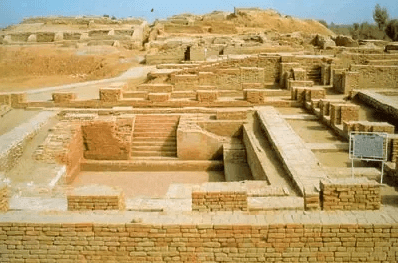 Great bath at Mohenjo-Daro
Great bath at Mohenjo-Daro - Another important structure was the Granary complex comprising of blocks with an overall area of 55 x 43 metres. The granaries were intelligently constructed, with strategic air ducts and platforms divided into units.
What are the types of Harappan Sculptures?
➢ Unicorn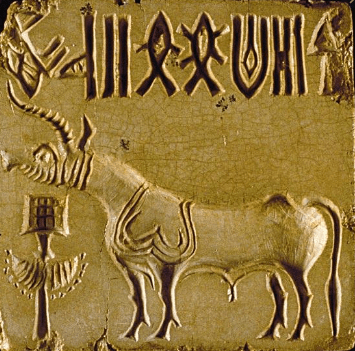 Harappa Unicorn Seal
Harappa Unicorn Seal
➢ Pashupati seal
- The standard seal is a square plaque with 2 x 2 square inches (river stone/steatite).
- They were mainly used as a unit of trade and commerce.
- They were also used as an amulet (to ward off the evil).
- They were also used as an educational tool (presence of presence of various symbols).
➢ Bearded man 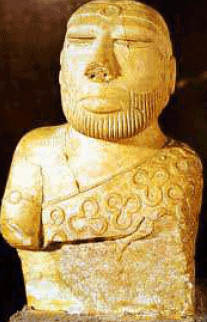 Sculpture of Indus Valley Civilization➢ Dancing girl
Sculpture of Indus Valley Civilization➢ Dancing girl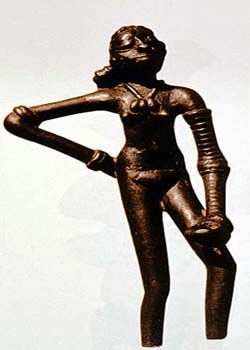 Art Dancing Girl of Mohenjo-daro
Art Dancing Girl of Mohenjo-daro
- The ‘lost wax technique” was used for making the metal-cast sculptures.
- The buffalo with its uplifted head, back and the sweeping horn was also made.
- Goats are of artistic merit.
➢ Terracotta
- Terracotta is a fire-baked clay and is handmade using the pinching method.
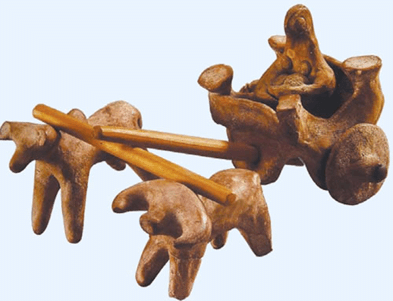 Toy carts with wheels
Toy carts with wheels
➢ Harappan Pottery
- Potteries were mainly plain, red and black painted.
- Plain pottery is more common than painted ware.
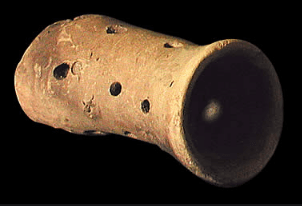 Perforated Pottery
Perforated Pottery - Plain pottery is generally of red clay, with or without a fine red or grey slip. It includes knobbed ware, ornamented with rows of knobs.
- The black painted ware has a fine coating of red slip on which geometric and animal designs are executed in glossy black paint.
- Ports were Used as perforated pottery (large hole at the bottom and small holes all over the wall, and probably was used for straining liquor).
➢ Beads and Ornaments
- Strands of evidence of dead bodies buried along with ornaments have also been found.
- Harappans were also conscious of fashion.
(b) What is The Mauryan Art And Architecture?

1. Mauryan court Art-Palaces
Some of the monuments and pillars belonging to this period are considered as the finest specimens of Indian art. The Mauryan architecture was embodied in timber, for rocks and stones were not as freely in use then. The art of polishing of wood reached so much perfection during the Mauryan period that master craftsmen used to make wood glisten like a mirror.
In 300 B.C., Chandragupta Maurya constructed a wooden fort 14.48 km long and 2.41 km wide, along the Ganges in Bihar. However, only a couple of teak beams have survived from this fort.
➢ Ashoka
- Ashoka was the first Mauryan Emperor who began the stone architecture. The stonework of the Ashokan Period (3rd century B.C.) was of a highly diversified order and comprised of lofty freestanding pillars, railings of the stupas, lion thrones and other colossal figures. While most of the shapes and decorative forms employed were indigenous in origin, some exotic forms show the influence of Greek, Persian and Egyptian cultures.
- The Ashokan period marked the beginning of the Buddhist School of architecture in India. It witnessed the construction of many rock-cut caves, pillars, stupas and palaces. A number of cave-shrines belonging to this period have been excavated in the Barabar and Nagarjuni hills and Sitamarhi in Bihar. The caves are simple in plan and are devoid of all interior decorative carvings. They served as the residences of the monks.

- The Ashokan rock-edict at Dhauli, near Bhubaneshwar, is considered to be the earliest rock-cut sculpture in India. It has a sculpted elephant on the top, which signifies the Emperor's conversion to Buddhism after his Kalinga victory.
2. Mauryan Court Art-Pillars
➢ Ashokan Pillars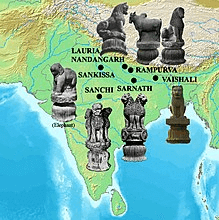 Geographical Spread of Ashokan Pillars
Geographical Spread of Ashokan Pillars
- The monolithic Ashokan pillars are marvels of architecture and sculpture. These were lofty free-standing monolithic columns erected on sacred sites. Each pillar was about 15.24 metres high and weighed about 50 tonnes and was made out of fine sandstone. They carried declarations from the king regarding Buddhism or any other topic.
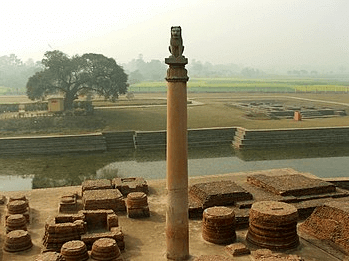 Ashoka Pillar
Ashoka Pillar
The pillars have four parts:
(i) The shafts are always plain and smooth, circular in cross-section, slightly tapering upwards and always chiseled out of a single piece of stone.
(ii) The capitals have the shape and appearance of a gently arched bell formed of lotus petals.
(iii) The abaci are of two types: square and plain and circular and decorated and these are of different proportions.
(iv) The crowning animals are either seated or standing, always in the round and chiselled as a single piece with the abaci.
The Sarnath pillar is one of the finest pieces of sculpture of the Ashokan period erected in 250 BC. Here, four lions are seated back to back. The four lions symbolize power, courage, confidence and pride. This Lion Capital of Ashoka from Sarnath has been adopted as the National Emblem of India and the wheel "Ashoka Chakra" from its base was placed at the centre of the National Flag of India. At present the Column remains in the same place where Lion Capital is at the Sarnath Museum.
3. Mauryan court Art-Stupas
- The stupa is a mound-like structure containing Buddhist relics, typically the ashes of deceased and used by Buddhists as a place of meditation.
- Ashoka was responsible for the construction of several stupas, which were large halls, capped with domes and bore symbols of the Buddha.
- The most important stupas are located at Sanchi, Bodhgaya, Amravati, and Nagarjunakonda.
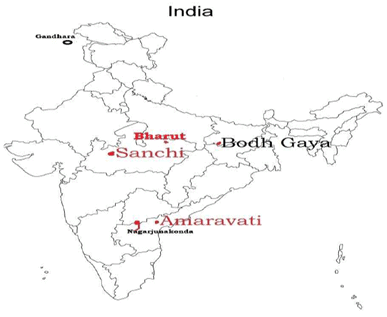 The stupas built for a variety of reasons, Buddhist stupas are classified based on form and function into five types:
The stupas built for a variety of reasons, Buddhist stupas are classified based on form and function into five types:
(i) Relic stupa - In which the relics or remains of the Buddha, his disciples and lay saints are interred.
(ii) Object stupa - In which the items interred are objects that belonged to the Buddha or his disciples such as a begging bowl or robe, or important Buddhist scriptures.
(iii) Commemorative stupas - Built to commemorate events in the lives of Buddha or his disciples.
(iv) Symbolic stupa - To symbolise aspects of Buddhist theology, for example, Borobudur is considered to be the symbol of "the Three Worlds (dhatu) and the spiritual stages (bhumi) in a Mahayana bodhisattva's character."
(v) Votive stupas - Constructed to commemorate visits or to gain spiritual benefits, usually at the site of prominent stupas which are regularly visited.
The shape of the stupa represents the Buddha, crowned and sitting in meditation posture on a lion throne. His crown is the top of the spire; his head is the square at the spire's base; his body is the vase shape; his legs are the four steps of the lower terrace, and the base is his throne.
The stupa represents the five purified elements:-
(i) The square base represents earth
(ii) The hemispherical dome/vase represents water
(iii) The conical spire represents fire
(iv) The upper lotus parasol and the crescent moon represents air
(v) The sun and the dissolving point represent the element of space
➢ Sanchi Stupa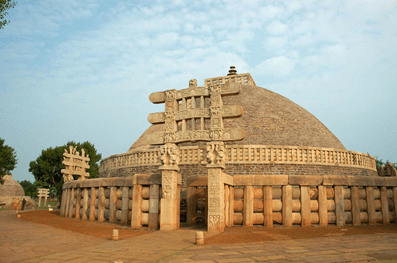
- Apart from the ruins of the stupa at Piprahwa (Nepal), the core of stupa No 1 at Sanchi can be considered as the oldest of the stupas.
- Originally built by Asoka, it was enlarged in subsequent centuries. An inscription by the ivory carvers of Vidisha on the southern gateway throws light on the transference of building material from perishable wood and ivory to the more durable stone.
➢ Amaravati Stupa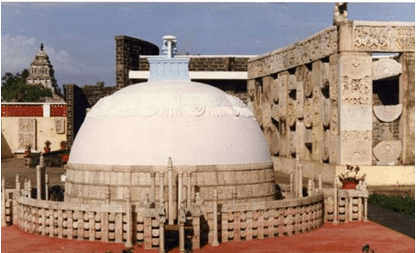
- Amaravati stupa, built in 2nd or 1st century BC, was probably like the one at Sanchi, but in later centuries it was transformed from a Hinayana shrine to a Mahayana shrine.
- Amaravati stupa is different from the Bharhut and Sanchi stupas. It had free-standing columns surmounted by lions near the gateways. The dome was covered with sculptured panels.
- The stupa had an upper circumambulatory path on the drum as at Sanchi. This path had two intricately carved railings. The stone is greenish-white limestone of the region.
➢ Bharhut Stupa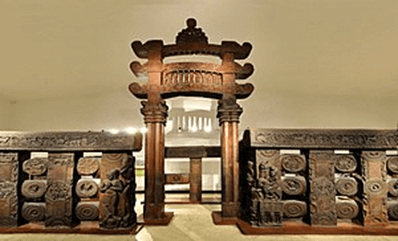 Remnants of Bharhut Stupa
Remnants of Bharhut Stupa
- The Bharhut stupa may have been established by the Maurya king Asoka in the 3rd century BCE, but many works of art were added during the Sunga period, with many friezes from the 2nd century BCE.
- The stupa (now dismantled and reassembled at Kolkata Museum) contains numerous birth stories of the Buddha's previous lives or Jataka tales.
➢ Gandhara Stupa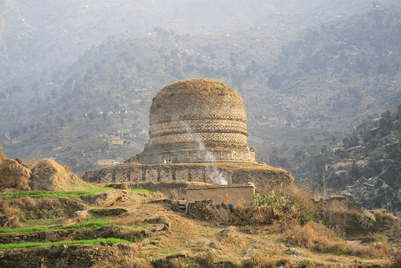
- The Gandhara stupa is a further development of stupas at Sanchi and Bharhut.
- In Gandhara stupas, the base, dome, and the hemisphere dome are sculpted. The stupa tapers upward to form a tower-like structure.
- The stupas of Nagarjunakonda in the Krishna valley were very large. At the base, there were brick walls forming wheel and spokes, which were filled with earth. The Maha Chaitya of Nagarjunakonda has a base in the form of Swastika, which is a sun symbol.
UPSC Aspirants after reading this article, are suggested to also read the related topics-
Nitin Singhania Summary: Indian Paintings
Nitin Singhania: Summary of Indian Handicrafts
Nitin Singhania: Summary of Indian Music
4. Mauryan Popular art-Caves
- Decorated entrance to Barabar caves
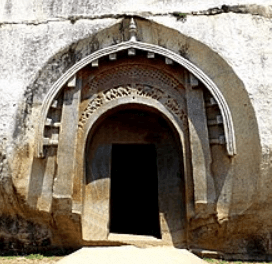 Barabar Caves
Barabar Caves - The Mauryan period also saw the firm establishment of rock-cut architecture.
- The notable rock-cut caves carved at Barabar and Nagarjuni hills near Gaya in Bihar are Sudama and Lomus Rishi cave.
- Architecturally, their main interest lies in being the earliest known examples in India of the rock-cut method.
- The facade of the Lomas Rishi cave is decorated with the semicircular chaitya arch as the entrance. The elephant frieze carved in high relief on the chaitya arch shows considerable movement.
- The interior hall of this cave is rectangular with a circular chamber at the back. The entrance is located on the sidewall of the hall.
- The cave was patronised by Ashoka for the Ajivika sect.
The two important features of the caves of this period were:
(i) Polishing inside the cave.
(ii) Development of artistic gateway.
5. Mauryan Popular art-Pottery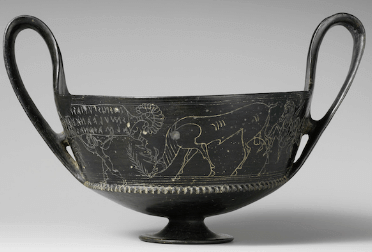 Specimen of Northern Black Polished Ware
Specimen of Northern Black Polished Ware
- The pottery associated with the Mauryan period consists of many types of wares. But the most highly developed techniques are seen in a special type of pottery known as Northern Black polished ware (NBPW), which was the hallmark of the preceding and early Mauryan Periods.
- The NBPW is made of finely levigated alluvial clay. It can be distinguished from other polished or graphite coated red wares by its peculiar luster and brilliance. It was largely used for dishes and small bowls.
6. Mauryan Popular Art-Sculpture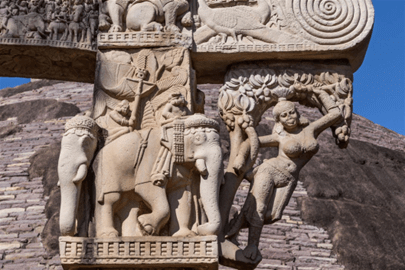 Yakshini Sculpture in a Torana at Sanchi Stupa
Yakshini Sculpture in a Torana at Sanchi Stupa
- The work of local sculptors illustrates the popular art of the Mauryan Period.
- This consisted of sculpture which probably was not commissioned by the Emperor.
- The patrons of the popular art were the local governors. Large statues of Yaksha and Yakshini are found at many places like Patna, Vidisha and Mathura.
- These monumental images are mostly in the standing position. One of the distinguishing elements in all these images is their polished surface.
- The depiction of faces is in the full round with pronounced cheeks and physiognomic detail.
- The life-size standing image of a Yakshini holding a chauri (flywhisk) from Didargunj near modern Patna is one of the finest examples of the sculptural tradition of the Mauryan Period.
 Yakshini holding a chauri (flywhisk)
Yakshini holding a chauri (flywhisk) - It is a tall, well proportioned, free-standing sculpture in the round made in sandstone with a polished surface.
- Yakshini is considered a folk goddess in all major religions.
(c) Post Mauryan Art
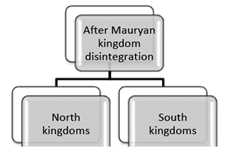
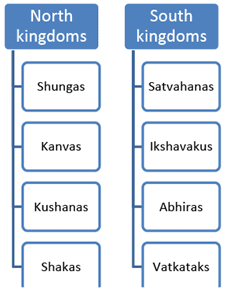
- The art of this period started reflecting the changing sociopolitical scenario as well.
- The architecture in the form of rock-cut caves and stupas continued, with each dynasty introducing some unique features of their own.
- Similarly, different schools of sculpture emerged and the art of sculpture reached its climax in the post-Mauryan period.
➢ Post Mauryan Period - Architecture
The north and south dynasties made advances in art and architecture in areas like stone construction, stone carving, symbolism and beginning of temple (or chaitya hall-prayer halls) and the monastery (or vihara-residential halls) constructions. Karle Chaitya, Vihara at Ellora
Karle Chaitya, Vihara at Ellora
- The period between the 2nd century B.C. and the 3rd century A.D. marked the beginning of the sculptural idioms in Indian sculpture where the elements of physical form were evolving into a more refined, realistic and expressive style.
- Under these dynasties, the Asokan stupas were enlarged and the earlier brick and woodworks were replaced with stone-works.
- The Sanchi Stupa was enlarged to nearly twice its size in 150 B.C. and elaborate gateways were added later.
- The Sungas reconstructed the railings around the Bharhut Stupa and built the toranas or the gateways.
- The Satavahanas constructed a large number of stupas at Goli, Jaggiahpeta, Bhattiprolu, Gantasala, Nagarjunakonda and Amravati.
- During the Kushan period, the Buddha was represented in human form instead of symbols. Buddha's image in endless forms and replicas became the principal element in Buddhist sculpture during the Kushan period.
- The Kushans were the pioneers of the Gandhara School of Art and a large number of monasteries; stupas and statues were constructed during the reign of Kanishka.
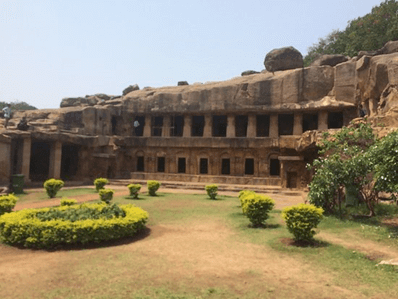 Udayagiri and Khandagiri Caves, Orissa
Udayagiri and Khandagiri Caves, Orissa - They were made under the Kalinga King Kharavela in 1st-2nd century BC near modern-day Bhubaneswar(for Jain monks).
- Udayagiri caves are famous for the Hathigumpha inscription which is carved out in Brahmi script.
- Ranigumpha cave in Udayagiri is double-storied and has some beautiful sculptures.
➢ Post Mauryan period-Sculpture
Three prominent schools of sculpture developed in this period at three different regions of India.
(i) Gandhara School of Art
(ii) Mathura School of Art
(iii) Amravati School of Art
(i) The Gandhara School of Art (50 B.C. to 500 A.D.)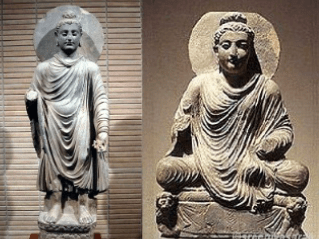
- The Gandhara region extending from Punjab to the borders of Afghanistan was an important centre of Mahayana Buddhism up to the 5th century A.D.
- Owing to its strategic location the Gandhara School imbibed all kinds of foreign influences like Persian, Greek, Roman, Saka and Kushan.
- The Gandhara School of Art is also known as the Graeco-Buddhist School of Art since Greek techniques of Art were applied to Buddhist subjects.
- The most important contribution of the Gandhara School of Art was the evolution of beautiful images of the Buddha and Bodhisattvas, which were executed in black stone and modelled on identical characters of Graeco-Roman pantheon. Hence it is said, "the Gandhara artist had the hand of a Greek but the heart of an Indian."
What are the important characteristics of Gandhara school are?
- Depiction of Lord Buddha in the standing or seated positions.
- The seated Buddha is always shown cross-legged in the traditional Indian way.
- Rich carving, elaborate ornamentation and complex symbolism.
- Use of greystone
- The best specimens of Gandhara art are from Jaulian and Dharmarajika stupa at Taxila and Hadda near Jalalabad in modern Afghanistan. The tallest rock-cut statue of Lord Buddha is also located at Bamiyan in modern Afghanistan.
(ii) The Mathura School of Art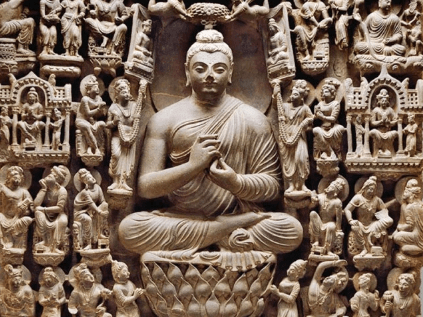
The Mathura School of art flourished at the city of Mathura between 1-3 A.D. and was promoted by the Kushans. It established the tradition of transforming Buddhist symbols into human form.
- The important characteristics of Mathura school are: The earliest sculptures of Buddha were made keeping the yaksha prototype in mind.
- They were depicted as strongly built with the right hand raised in protection and the left hand on the waist.
- The figures produced by this school of art do not have moustaches and beards as in the Gandhara Art.
- Spotted red sandstone is mainly used.
- Here along with the Buddha, the kings, the royal family were included in the architecture.
- It not only produced beautiful images of the Buddha but also of the Jain Tirthankaras and gods and goddesses of the Hindu pantheon.
- The Guptas adopted the Mathura School of Art and further improvised and perfected it.
(iii) The Amravati School of Art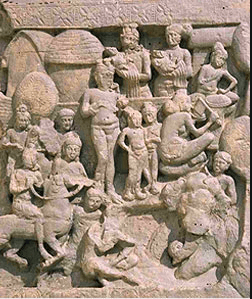 Amravati School of Sculpture
Amravati School of Sculpture
The Amravati school of Art evolved during Satavahana period. This school of art developed at Amravati, on the banks of the Krishna River in modern Andhra Pradesh. It is the site for one of the significant Buddhist stupas of South India. The stupendous stupa could not withstand the ravages of time and its ruins are preserved in the London Museum. This school of art had a great influence on art in Sri Lanka and South-East Asia as products from here were carried to those countries.
If you want to watch a video to understand this even better, here is a link for the same: Indian Architecture, Sculpture & Pottery- 1
In this document you have learnt
- The grid layout planning of the cities with roads at exact right angles is an ancient system that was implemented in the cities of this particular civilization. The houses were built of baked bricks. Bricks of fixed sizes, as well as stone and wood, were also used for building.
- The ‘lost wax technique” was used for making the metal-cast sculptures. The buffalo with its uplifted head, back and the sweeping horn was also made.
- The Ashokan period marked the beginning of the Buddhist School of architecture in India. It witnessed the construction of many rock-cut caves, pillars, stupas and palaces. A number of cave-shrines belonging to this period have been excavated in the Barabar and Nagarjuni hills and Sitamarhi in Bihar.
- The Sarnath pillar is one of the finest pieces of sculpture of the Ashokan period erected in 250 BC. Here, four lions are seated back to back. The four lions symbolize power, courage, confidence and pride.
- The stupas of Nagarjunakonda in the Krishna valley were very large. At the base, there were brick walls forming wheel and spokes, which were filled with earth. The Maha Chaitya of Nagarjunakonda has a base in the form of Swastika, which is a sun symbol.
- Udayagiri caves are famous for the Hathigumpha inscription which is carved out in Brahmi script. Ranigumpha cave in Udayagiri is double-storied and has some beautiful sculptures.
|
110 videos|652 docs|168 tests
|
FAQs on Nitin Singhania Summary: Indian Architecture, Sculpture & Pottery- 1 - History for UPSC CSE
| 1. What are the main characteristics of Indian architecture? |  |
| 2. How did ancient Indian architecture evolve over time? |  |
| 3. What are the major types of Indian sculpture? |  |
| 4. What role does pottery play in Indian culture? |  |
| 5. How can one effectively study Indian architecture, sculpture, and pottery for UPSC exams? |  |






















